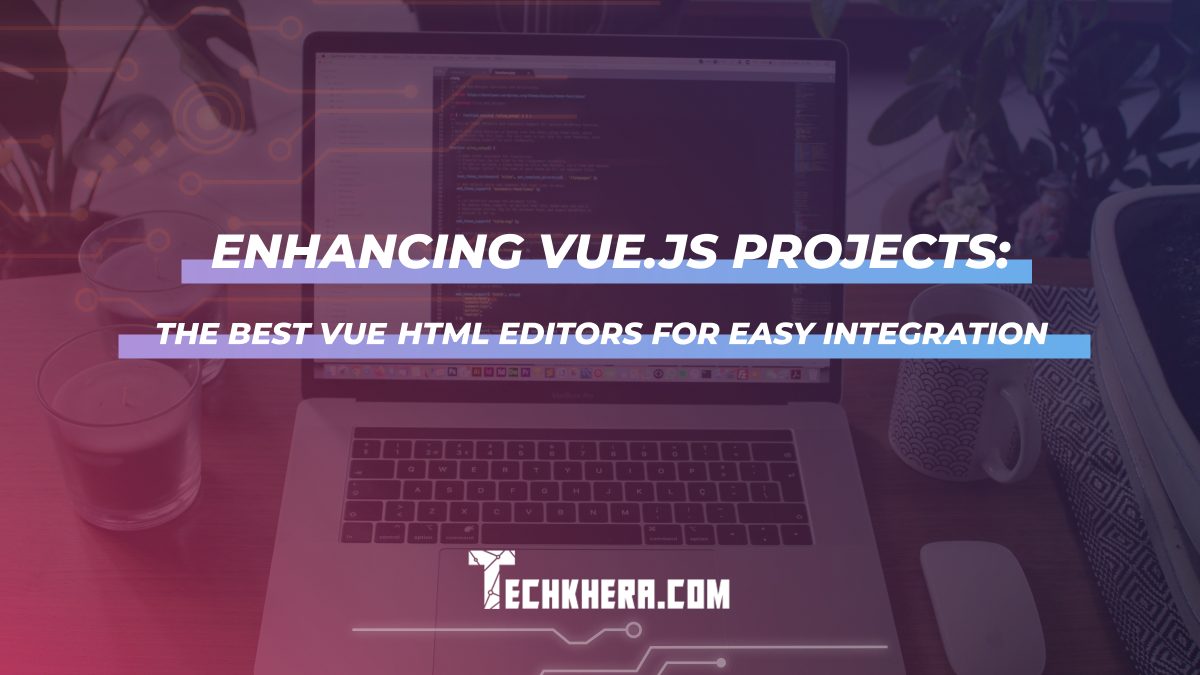
Enhancing Vue.js Projects: The Best Vue HTML Editors for Easy Integration
Embarking on the dynamic journey of Vue.js development? Brace yourself for a game-changer! In the realm of seamless integration, Vue HTML editors emerge as unsung heroes, offering a plug-and-play experience that transforms the way you craft and manage HTML content.
Dive into the heart of efficiency as we explore the key features that set top Vue HTML editors apart. Learn the art of integration with our comprehensive guide, and witness real-world success stories that unveil the true impact on workflows. Ready to supercharge your Vue.js projects? Join us on a quest to discover the best Vue HTML editors for a development experience like never before!

Contents
What is a Vue HTML editor?
At their core, Vue HTML editors simplify the process of handling HTML elements within Vue jects. In doing so, they make it easier for developers to create dynamic and interactive user interfaces. Thus, these editors offer developers an intuitive solution for handling rich text editing and content creation.
Unlike traditional editors, these are designed with Vue.js compatibility in mind. The plug-and-play aspect of Vue HTML editors ensures that developers can effortlessly incorporate these tools into their Vue.js projects. And that too without extensive configuration or complex setup processes. This makes them a valuable asset for enhancing the user experience and streamlining content management within web applications.
Key features of top Vue HTML editors
Most Vue HTML editors come fully equipped with interesting features. But there are essential elements that make certain options like Froala stand out.
- Rich text editing capabilities: include text formatting, image insertion, link creation, and other content manipulation. The integration of a familiar and user-friendly interface enhances the overall editing experience.
- Real-time preview and WYSIWYG editing: provide developers with an instant preview of their HTML code changes. What You See Is What You Get (WYSIWYG) editing allows users to create and edit content similar to how it will appear on the final webpage. Together, they allow for quicker iterations and a more efficient development process.
- Customization options: allow developers to tailor the appearance and behavior of the editor to suit the specific requirements of their Vue.js projects. The best editors usually provide themes and toolbar configurations. They also equip you with the ability to add or remove specific editing features.
- Integration with Vue.js components: ensures that developers can incorporate the editor into their Vue.js applications without encountering compatibility issues. A good Vue HTML editor understands the Vue.js architecture perfectly. This makes it easy for developers to embed and manipulate components directly within the editor.
- Code completion and suggestions: allow for enhanced coding experiences. This not only speeds up coding but also helps prevent errors, contributing to the overall reliability of the project.
- Cross-browser compatibility: ensure a consistent experience for users, regardless of their browser choice. Top Vue HTML editors are built with cross-browser compatibility in mind. Thus, they save developers from unexpected compatibility and consistency issues.
Integrating HTML editors in Vue.js
Now that we understand what a Vue HTML Editor is and what it does let’s get our hands dirty! Here’s how you can install and configure an HTML editor in Vue.js:
- Start by installing the editor library using a package manager like npm or yarn.
- Once installed, import the editor component into your Vue file and include it in your template. This step often involves setting up event listeners and defining any necessary options.
- Bind the HTML editor component to your Vue data model to enable two-way data binding. This allows you to synchronize the content of the editor with your Vue application’s state.
- Implement event handling to capture user interactions within the HTML editor. These include input changes or specific actions triggered by the user that will update your application’s logic accordingly.
The specific integration process may vary based on the chosen HTML editor. However, some common patterns include:
- using slots for customization,
- leveraging component lifecycle hooks for initialization and cleanup,
- incorporating editor-specific methods for advanced functionality, and
- incorporating lazy loading or asynchronous loading of the HTML editor.
Following these patterns ensures a consistent and reliable Vue.js editor integration experience. It also ensures that the editor’s impact on the overall application performance is minimized.
Case studies
Vue.js is all around us, whether we notice it or not. For example, did you know that the popular clothing brand Louis Vuitton’s international website is running on Vue.js? The brand’s exquisite craftsmanship is mirrored in its website, and the seamless integration with Vue components ensures a smooth browsing experience for its myriad users.
Next, we look at Infinity, an all-encompassing project management platform. It leverages Vue.js to provide users with unparalleled organizational flexibility. The Vue.js-powered customizable structure and robust overview features ensure that projects of any size and complexity remain effortlessly organized. With data accessibility just a click away, Infinity eliminates resource concerns. Thus, it empowers users to maximize productivity and foster seamless team collaboration. Vue.js plays a pivotal role in creating a clutter-free, adaptable workspace, allowing users to stay organized in the most flexible way
Finally, we see how Storyblok, a versatile headless CMS, collaborates with Vue.js to empower developers and content creators. Offering flexibility for diverse use cases such as corporate websites, e-commerce, and mobile apps, Storyblok builds a harmonious bridge between content creation and development. Its seamless Vue integration and powerful REST and GraphQL APIs allow for component-based extensibility. With a visual editor previewing changes, Storyblok ensures a smooth workflow for delivering dynamic content to Vue applications.
Choosing the right Vue HTML editor
Having equipped ourselves with the necessities of efficient HTML editing in Vue, let’s look at some considerations to make when choosing a Vue HTML editor.
- Ensure that the HTML editor is specifically designed for integration with Vue.js. This functionality is crucial to avoid compatibility issues and ensure a seamless development experience.
- Evaluate the customization options offered by the HTML editor. The ability to customize aspects of the editor will allow you to tailor the tool to your unique requirements.
- Evaluate the editor’s performance under various scenarios to ensure it meets the scalability needs of your project. A well-designed editor should handle large amounts of content and complex editing operations without compromising performance.
- Choose an HTML editor with an active community and comprehensive documentation. A strong community ensures ongoing support and updates, while thorough documentation simplifies the integration process and troubleshooting.
- Review performance metrics to ensure the HTML editor doesn’t introduce significant overhead. Opt for editors that prioritize efficiency and responsiveness.

Conclusion
- Recap the importance of choosing the right Vue HTML editor for project success.
- Encourage readers to explore various editors and find the best fit for their needs.
By carefully considering these criteria, developers can choose the right Vue HTML editor that seamlessly integrates into their Vue.js projects, enhancing the overall development experience and improving the functionality of web applications.
In the exhilarating realm of Vue.js and dynamic web development, the journey doesn’t end — it evolves! Armed with the prowess of top Vue HTML editors, you’re now equipped to sculpt digital experiences with unparalleled finesse. As you bid farewell to this exploration, remember: Vue.js isn’t just a framework; it’s a gateway to innovation.
Harness the simplicity, revel in the power, and let your creativity run wild. The code may find its closure, but the possibilities are boundless. So, go ahead and dive into the Vue.js wonderland. Armed with newfound knowledge, explore a future where each line of code is a brushstroke on the canvas of innovation. Keep coding, and keep creating!
FAQs
What makes Vue HTML editors different from traditional HTML editors?
Vue HTML editors are designed to integrate seamlessly with Vue.js frameworks, offering features like reactive data binding and component-based architecture, which enhance the development workflow specifically for Vue.js applications.
Can Vue HTML editors be used in large-scale projects?
Yes, Vue HTML editors are scalable and can be effectively used in large-scale projects. They offer robust features and customizability, making them suitable for complex applications.
How easy is it to integrate a Vue HTML editor into an existing project?
Integrating a Vue HTML editor into an existing project is generally straightforward, thanks to its plug-and-play nature. Most editors come with detailed documentation and support modern development practices, making the integration process user-friendly.
